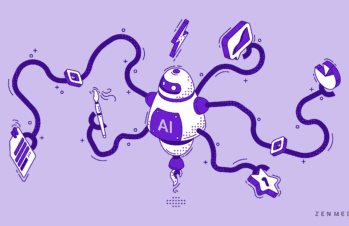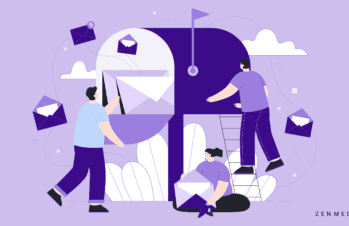As the marketing world evolves, one truth remains constant: the customer is king. While businesses strive to capture their target audience’s attention and loyalty, leaders realize that one-size-fits-all approaches no longer work. Generic content doesn’t cut through the noise or leave a lasting impression. But personalized content? That engages, converts, and ultimately earns trust.
Marketers today must deliver tailored experiences that speak directly to the needs and interests of their individual consumers. According to McKinsey, 71% of consumers now expect personalized interactions from the businesses they deal with—and 76% get frustrated when companies don’t deliver.
The Benefits of Content Personalization
Standing out from the crowd requires more than just catchy slogans and flashy visuals. It demands a deep understanding of your customers’ needs and a personalized approach that goes beyond surface-level marketing tactics.
Capturing and holding customers’ attention is no small feat. With countless distractions vying for their limited time and energy, businesses must find innovative ways to break through the noise. By tailoring your content to match the preferences, interests, and pain points of individual customers, you can create a deeper relationship.
Imagine a scenario where a potential customer visits your website and is immediately greeted by content that speaks directly to their specific needs. They feel seen, understood, and valued. This personalized approach drives customers to explore further, engage with your brand, and, ultimately, make a purchase.
The result? Enhanced customer satisfaction, increased loyalty, and a lasting impression that sets you apart from the competition.
Increased Conversion Rates: Turning Browsers into Buyers
At the heart of every marketing endeavor lies the ultimate goal: conversion. Personalized content can turn browsers into active buyers by strategically aligning your content with each customer’s unique journey—meaning you can guide them along the sales funnel with precision and finesse.
When a customer encounters content that directly addresses their pain points, offers relevant solutions, and showcases the value your product or service brings to their lives, the path to conversion becomes smoother and more enticing. A personalized CTA that speaks to a customer’s needs can be a catalyst for taking the final leap from consideration to purchase.
By optimizing your content personalization, you empower your brand to convert at higher rates, driving revenue.
Driving Business Growth: Personalization as the Fuel for Success
Sustained growth is the ultimate measure of success. When customers experience personalized content that consistently meets their needs (or exceeds their expectations), a virtuous cycle is set in motion. Satisfied customers become loyal advocates, spreading positive word-of-mouth referrals and championing your brand.
Repeat purchases become the norm as customers trust you to understand their preferences and consistently deliver exceptional experiences. This potent combination of customer satisfaction, loyalty, and advocacy fuels sustainable business growth and positions your brand as a market leader.
Implementing Effective Content Personalization
In the age of data-driven marketing, businesses have an unprecedented opportunity to tap into a treasure trove of customer insights and leverage them to deliver personalized experiences that leave a lasting impact. By combining the power of customer data with cutting-edge tech, implementing effective content personalization is not only attainable but also indispensable for driving results.
Armed with comprehensive customer data, you can uncover invaluable insights that enable you to craft tailored content that truly resonates with your audience. The first step is to analyze customer data meticulously, mining it for patterns, preferences, and pain points to inform your personalization strategy.
By collecting and organizing relevant customer data, ranging from demographic information to browsing behavior, purchase history, and social media interactions, you gain the power to build accurate customer profiles. These profiles serve as the foundation for creating personalized content that speaks directly to the unique needs and interests of individual customers.
Creating Personalized Content: A Symphony of Relevance
Personalization goes beyond simply addressing customers by their first names. It’s about crafting a symphony of relevance that strikes a chord with each individual. To achieve this, marketers must go beyond surface-level personalization tactics and truly understand what drives their customers.
Segmentation is a key strategy in personalizing content effectively. By categorizing your audience based on common characteristics, preferences, or behaviors, you can tailor your messaging and deliver experiences that resonate deeply within each segment. Whether it’s addressing specific pain points, highlighting relevant benefits, or showcasing personalized product recommendations, the key is to make each customer feel seen and understood.
Leveraging Artificial Intelligence and Machine Learning: The Power of Automation and Prediction
Artificial intelligence (AI) and machine learning (ML) revolutionize how businesses approach content personalization. These technologies have the remarkable ability to analyze vast amounts of customer data, identify patterns, and automate the delivery of personalized content recommendations.
AI-powered personalization engines can dynamically adapt content in real time based on user interactions, ensuring that each customer receives the most relevant and timely information. ML algorithms can predict customer preferences and behaviors, enabling businesses to proactively deliver personalized experiences before customers even realize they need them.
By embracing AI and ML in your efforts, you empower your marketing team to scale personalization without sacrificing efficiency or accuracy. Incorporating content personalization into your customer journey is no longer a luxury; it is a necessity.
Strategies for Integrating Personalization into Your Content Marketing Strategy
Adding content personalization to your overall B2B content marketing strategy requires careful planning and a deliberate approach. By aligning personalization with your business goals, developing a solid framework, and continuously testing and optimizing your efforts, you can seamlessly integrate personalization into every stage of your customer journey, driving impactful results.
Before diving headfirst into personalization tactics, it is crucial to align your personalization efforts with your broader business goals. Clearly define your objectives and desired outcomes, whether it’s increasing conversations, improving customer retention, or expanding market share. By understanding the specific goals you want to achieve, you can tailor your personalization strategy to directly support those objectives.
Map out the customer journey and identify key touchpoints where personalized content can make a significant impact. From the initial brand awareness stage to the final purchase decision, pinpoint the moments where personalized experiences can drive the desired outcomes. By aligning personalization with your business goals and mapping it strategically within the customer journey, you set the stage for a seamless integration that maximizes results.
Developing a Personalization Framework: Guidelines for Success
Creating a personalization framework is essential for ensuring consistency and effectiveness in your personalization efforts. Establish guidelines and best practices that govern how personalization is executed across your content channels. This includes defining customer segments, determining the types of personalized content to deliver, and establishing rules for dynamic content adaptation.
Empower your content creators and marketers with the tools and resources to personalize effectively. Provide them access to customer data, insights, and personalization technologies that enable them to deliver targeted, relevant, and impactful content at scale. By fostering a culture of personalization within your organization and providing the necessary support, you set the stage for successful implementation and execution.
Testing and Optimization: Refining Personalization for Maximum Impact
Personalization is not a one-time endeavor; it’s an ongoing process that requires continuous testing and optimization. Employ A/B testing methodologies to experiment with different variations of personalized content and measure their effectiveness. Analyze the results and gather insights to inform future iterations and refinements.
Leverage customer data analytics to gain a deep understanding of how personalized content performs across different segments, channels, and stages of the customer journey. Monitor key metrics such as engagement rates, conversion rates, and customer satisfaction to gauge the impact of your personalization efforts. Use these insights to fine-tune your strategies, iterate on your content, and constantly improve the effectiveness of your personalized experiences.
Companies should embrace a culture of experimentation, data-driven decision-making, and continuous optimization. Incorporating content personalization into a content marketing strategy delivers experiences that captivate and convert.
Ready to see how content personalization can transform your B2B marketing strategy? Reach out.





